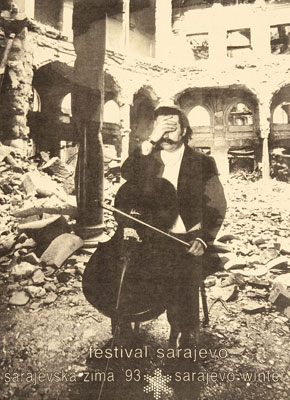The period of the Republic of Bosnia and Herzegovina
Renewal of Bosnian and Herzegovinian statehood
The idea of historian Enver Imamović to take the medieval coat-of-arms and flag of the first Bosnian King Tvrtko I Kotromanić as the identity of the new - democratic Republic of Bosnia and Herzegovina was accepted in the Parliament of Bosnia and Herzegovina (without the participation of Serb political representatives) on 4 May 1992. For its proponent, it meant the renewal of the country's independence and, as such, it became the symbol of Bosnian-Herzegovinian independence.
The flag and the fleur-the-lys coat-of-arms were the official symbols of Bosnia and Herzegovina until 4 February 1998, when Carlos Westendorp, the then High Representative in BiH took a decisionon the flag and the coat-of-arms - the current emblems of Bosnia and Herzegovina. It is interesting to mention that in the modern era, the period covered by this book, none of the adopted and official identities of Bosnia and Herzegovina reflect the true picture of the cultural and spiritual heritage of the people living in the country. Thus these new emblems speak more about its geographic position and European environment (the triangle form, blue background and yellow stars), and less about the culture and traditions of its inhabitants.
Radio Wall Sarajevo
Radio Wall editiwas launched in 1993. The first published book was Thousand and One Nights (Tausend und eine Nacht) edited by Zdravko Grebo and Semezdin Mehmedinović. Numerous works followed such as Maruša Krese's Poems from Sarajevo, Nermina Kurspahić's Hyatus, Alma Lazarevska's Sarajevo Solitaire, Karim Zaimović's The Secret of Raspberry Jam, Nenad Veličković's Sarajevo Gastronauts, Patrick Rambaud's Battle, Marguerite Yourcenar's Alexis, Hanan Al-Sheeih's Zehra's Story, as well as Elements of European Law and Urbicide in Mostar. During 1995, Radio Wall launched the Wallpaper review. Radio Wall was an important social and cultural meeting point in the besieged city. Music produced by the alternative Sarajevo rock groups that were linked to Radio Wall and participated in a concert held on14 January 1995 in the Sloga Club (Down, Pessimistic Lines, D. Throne, Hindustan Motors, Gnu, Grafit, Lezi majmune, Sikter, A.P. Sound, Bedburg, Beastly Stroke, and Ornamenti) was published on a compact disc under the title Rock Under the Siege. The cover for this cd was designed by Lejla Hodžić.
Witnesses of existence '94
Witnesses of Existence (Zoran Bogdanović, Sanjin Jukić, Edo Numankadić, Nusret Pašić, Mustafa Skopljak, and Petar Waldeg), PasquArt, Biel - Bienne, Switzerland, 28 May - 3 July 1994, produced by Pro Helvetia and the Obala Gallery ; and The New York Kunsthalle, USA, 28 February - 3 April 1994, produced by the Obala Gallery
Srebrenica
A photo from the series of documentary photographs by Tarik Samarah taken between 2000 and 2003, during the exhumation of the victims of genocide in Srebrenica that was committed between 11 and 19 July 1995 by the Army of Republika Srpska in the UN safe zone Srebrenica. To date, 8,732 victims have been identified. The entire opus of Tarik Samarah, thematically defined by the exhumation of victims of the Srebrenica genocide, was published in 2006, in the monograph Srebrenica. Today, there is also a museum in Sarajevo that keeps the memory of Srebrenica. The museum has been equipped thanks to support provided by the Turkish Development Agency - TIKA and opened for public on 12 July 2012.
Almin Zrno took this photograph in Srebrenica on 11 July 2003, during the funeral - burial of innocent victims of the Srebenica genocide thus making an epic work about pain. The pain dimension he recorded on the face of this woman - mother mourning her lost children ("With my death my whole world has died" - Mak Dizdar) as if it was the face of the soil - gaunt, chapped, wrinkled, dried. As if life has moved elsewhere and only silence - lasting and timeless - has remained. That is why it is no wonder that Safet Zec, a painter with a special sensitivity - the painter of Bosnia - found a motive for his epic on Srebrenica in this photographic work of Almin Zrno.
This poster was printed in New York in 200 copies
The first Sarajevo Film Festival was held from October 25 to November 5, 1995. At that time, the siege of Sarajevo was still in progress and it was assumed that the visit would be low. However, a surprising number of 15,000 people came to watch movies, of which 37 were from 15 different countries. The festival has grown rapidly into a prominent film festival in Southeast Europe, attracting more than 100,000 people per year to all programs and projections of hundreds of films from 60 countries.
The cellist Vedran Smajlović plays in the destroyed Sarajevo National, photo Kemal Hadžić, design of poster by Enis Selimović, 1993. After the first year of the war (1992), when the schools and faculties stopped working, the resistance to the aggression was manifested by their reopening. Classes were organized under the shelling, without electricity; the cultural life was maintained by organizing theatre performances, or guest performances by world recognized intellectuals. All this was a heroic act in the city under the siege. Vedran Smajlović is one from them.
Bosnian and Herzegovinian artists who acquired their artistic reputation in the country and abroad in the pre-war period, among which are the most important Dževad Hozo, Seid Hasanefendić and Salim Obralić, each in their own way, with their artwork and organized exhibitions, contributed to the cultural life in Sarajevo during the city under the siege.






